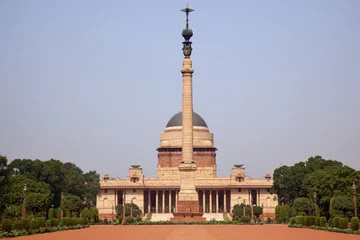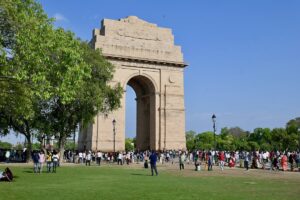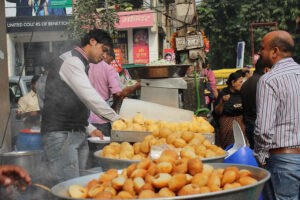An Essay on Rastrapati Bhawan in Delhi
Rashtrapati Bhavan: An Architectural and Historical Marvel
Rashtrapati Bhavan, located in New Delhi, India, stands as a testament to the grandeur of British colonial architecture and the evolution of India’s political landscape. Originally conceived as the residence of the British Viceroy, this monumental structure has since become the official residence of the President of India, embodying the nation’s democratic values and historical journey.
Architectural Significance
Designed by British architect Edwin Lutyens, Rashtrapati Bhavan is a striking example of the fusion of Western and Eastern architectural styles. The building’s design blends classical elements with Indian motifs, reflecting Lutyens’ intent to create a structure that would be both impressive and culturally resonant. The dome of Rashtrapati Bhavan, inspired by St. Paul’s Cathedral in London, is one of its most prominent features, symbolizing the continuity of colonial and indigenous influences.
The structure is built of sandstone, a material chosen for its durability and aesthetic appeal. The main building is set within a 330-acre estate, encompassing beautifully landscaped gardens and imposing gateways. The Mughal Gardens, which are open to the public during specific periods, showcase intricate Persian-style landscaping that complements the building’s grandeur.
Historical Context
Construction of Rashtrapati Bhavan began in 1912 and was completed in 1929, during the height of British rule in India. The building was initially intended to serve as the residence of the Viceroy of India, who represented the British monarch. The choice of location, on Raisina Hill, was strategic, symbolizing British authority and overseeing the newly established capital city, New Delhi.
With the transfer of power in 1947, Rashtrapati Bhavan transitioned from being a symbol of colonial rule to becoming the residence of the President of independent India. The building witnessed the country’s journey from colonialism to independence, and now, it stands as a symbol of India’s democratic ethos and political stability.
Cultural and Political Significance
Rashtrapati Bhavan is not merely an architectural marvel; it is a focal point of Indian politics and culture. It serves as the venue for numerous state functions, including the swearing-in ceremonies of the President, official receptions, and national celebrations. The building also hosts diplomatic meetings and international delegations, reinforcing its role as a central hub in India’s political landscape.
Furthermore, Rashtrapati Bhavan reflects India’s rich cultural heritage through its diverse architectural elements and the artworks that adorn its interiors. The building’s design incorporates motifs from Indian art and architecture, symbolizing the amalgamation of British and Indian influences.
What materials are used in Rashtrapati Bhavan?
Rashtrapati Bhavan, the official residence of the President of India, uses a variety of materials in its construction. The primary materials include:
1. Red Sandstone: This is the most prominent material, used for the exterior facades and pillars. It was sourced from the Jaipur region.
2. Marble: White marble is used extensively in the interior, including floors, walls, and decorative elements.
3. Iron and Steel: These materials are used in the structural framework and for decorative ironwork.
4. Wood: Richly carved wood is used in some interior sections, including paneling and doors.
5. Bronze: Some decorative elesments, including the massive front gates, are made of bronze.
The building’s construction reflects a blend of Indian and Western architectural styles, with materials chosen to support its grandeur and durability.
What is the symbol of Rashtrapati Bhavan?
The symbol of Rashtrapati Bhavan, the official residence of the President of India, is the “Emblem of India.” This emblem features the Ashoka Chakra at the center, flanked by four lions standing back to back, symbolizing power, courage, and confidence. The emblem also includes the motto “Satyamev Jayate” (Truth Alone Triumphs) written in Devanagari script.
What work is done in Rashtrapati Bhavan?
Rashtrapati Bhavan, the official residence of the President of India, serves several functions. It is a ceremonial and administrative center where official state functions and ceremonies are held.
The President’s office and the offices of their staff are located there, and it is also a venue for receiving foreign dignitaries and hosting important events. Additionally, Rashtrapati Bhavan plays a role in the governance of India by being involved in the appointment of key officials and the execution of presidential duties.
What is the real name of Rashtrapati Bhavan?
The real name of Rashtrapati Bhavan is the “Presidential Estate” or “President’s House.” Rashtrapati Bhavan is the official residence of the President of India, located in New Delhi.
About Mughal garden in Rashtrapati Bhavan
The Mughal Gardens at Rashtrapati Bhavan in New Delhi are renowned for their beautiful layout and design, reflecting traditional Mughal landscaping principles. These gardens cover about 13 acres and feature a range of flora, including tulips, roses, and other seasonal flowers.
Designed by Sir Edwin Lutyens and Herbert Baker, they are divided into several sections, such as the Central Garden, the Long Garden, and the Circular Garden. The gardens are typically open to the public during specific times of the year, particularly during the annual Udyanotsav, when visitors can view the blooming flowers and well-maintained landscapes.
Conclusion
Rashtrapati Bhavan is much more than a presidential residence; it is an enduring symbol of India’s historical transition and architectural innovation. Its grandeur and design reflect a unique blend of Western and Indian styles, making it a significant landmark in New Delhi. As the residence of the President of India, it continues to represent the values of democracy and the rich cultural heritage of the nation, standing as a testament to the country’s journey through time.






